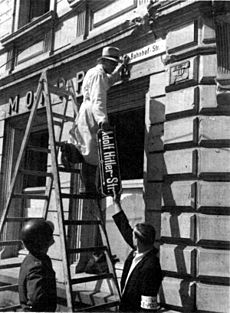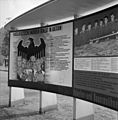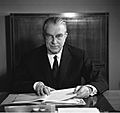Denazification facts for kids
Denazification was a big plan started by the Allied countries after World War II. Their goal was to remove all traces of Nazism from Germany and Austria. This meant getting rid of Nazi ideas and people from everyday life, including how people lived, what they learned, what they read, how the economy worked, the justice system, and the government.
The Allies did this by removing people who were part of the Nazi Party or the SS (a powerful Nazi group) from important jobs. They also broke up or weakened any groups connected to Nazism. This program began right after the Second World War ended and was officially agreed upon in August 1945 at the Potsdam Agreement.
Contents
Why Denazification Was Needed
After World War II, Germany was defeated, and the Allies (like the United States, Great Britain, France, and the Soviet Union) took control. They found that Nazi ideas had spread deeply throughout German society. Many people had supported the Nazis, or at least gone along with their rules.
The Allies believed that for Germany to become a peaceful, democratic country, it needed to completely get rid of Nazi influence. They wanted to make sure that such a terrible war and hateful ideas could never happen again.
How Denazification Worked
The denazification process involved several steps:
Finding Nazi Supporters
The Allies tried to identify everyone who had been a member of the Nazi Party or had actively supported it. They used questionnaires and investigations to figure out who was involved. Millions of Germans had been members of the Nazi Party, so this was a huge task.
Removing People from Power
People who were identified as strong Nazi supporters were removed from their jobs. This included teachers, judges, police officers, government officials, and business leaders. The idea was to stop them from spreading Nazi ideas or having influence in society.
Changing Laws and Symbols
New laws were put in place to ban Nazi organizations and symbols. Nazi flags, emblems, and propaganda were removed from public places. Streets named after Nazi leaders were renamed, just like in the picture above.
Re-educating the Public
The Allies also tried to re-educate the German and Austrian people. They controlled newspapers, radio, and schools to teach democratic values and explain the horrors of the Nazi regime. They wanted people to understand what had happened and why Nazism was wrong.
Challenges and Different Approaches
Denazification was a very difficult process, and the different Allied powers had their own ways of doing it.
American Zone
The United States aimed for a very strict denazification at first. They wanted to remove all former Nazis from public life. However, they soon realized that this was hard to do without causing chaos, as so many people had been involved. They also needed experienced people to help rebuild the country.
British Zone
The British approach was a bit more practical. They focused on removing the most dangerous Nazis and those in very important positions. They also tried to get the German people to take more responsibility for their own denazification.
French Zone
France also had its own methods, often focusing on cultural and educational changes to remove Nazi influence.
Soviet Zone
In the Soviet-controlled part of Germany (which later became East Germany), denazification was very strict, especially against former Nazis who were also anti-communists. They removed many people from their jobs and sometimes arrested them.
Results and Legacy
Denazification had mixed results. While many high-ranking Nazis were punished, and Nazi organizations were broken up, it was impossible to completely remove every former Nazi from society. Some people who had been involved in the Nazi regime later found their way back into important jobs in West Germany. For example, German Chancellor Kurt Georg Kiesinger was a former member of the Nazi Party.
Despite its challenges, denazification was an important step in helping Germany and Austria move away from their Nazi past and become democratic countries. It showed the world that the Allies were serious about changing Germany and preventing another war.
Images for kids
-
A 1948 certificate showing someone was cleared of Nazi ties, from Wattenscheid in the British Zone.
-
A poster from the 1947 state elections in North Rhine-Westphalia, saying "For a quick and fair denazification vote CDU".
-
German Chancellor Kurt Georg Kiesinger (right) was a former member of the Nazi Party.
-
Adenauer's State Secretary Hans Globke helped write the antisemitic Nuremberg Race Laws.
See also
 In Spanish: Desnazificación para niños
In Spanish: Desnazificación para niños









